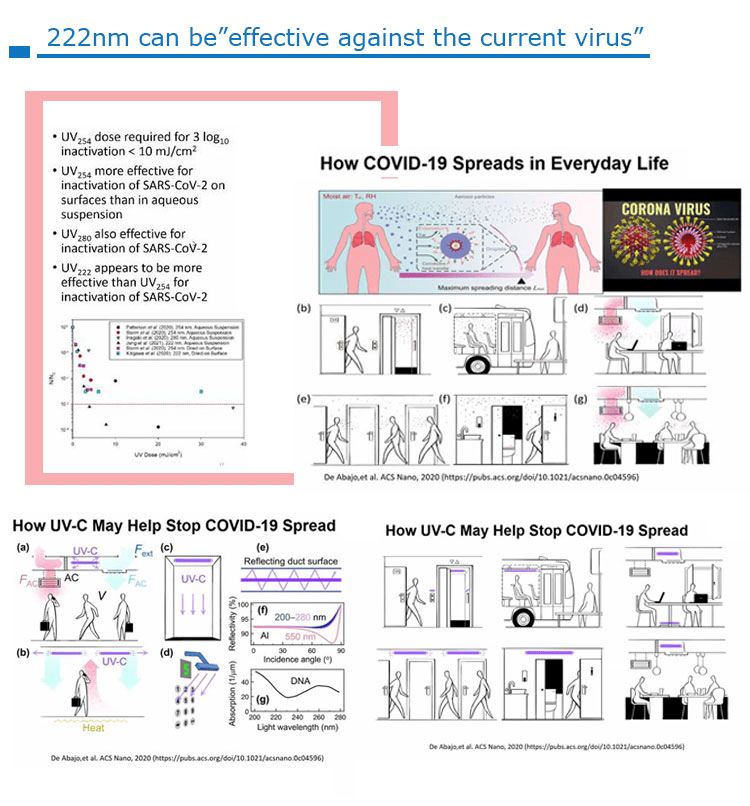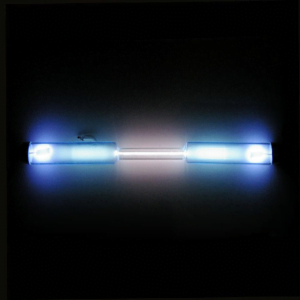Our Technology
Let's Work Together
The World Health Organization predicts global demand for Far UV Light Sterilization Systems will exceed 925 million by 2030, driving opportunities for Far UV 222nm Excimer Light technology. Our disinfection lamps offer 99.9% reduction of airborne viruses, bacteria, and pathogens in various settings—from cruise ships to hospitals—by destroying their DNA/RNA making them effective even against mutations.


How does FUV-222nm excimer light radiation work?
Today we know that the specific frequency most efficient at stopping viruses, pathogens and bacteria, COVID-19 is at an FUV- 222nm excimer radiation. DNA has its absorption peak at 222 nm wavelength and very efficiently absorbs energy from excimer light at this wavelength. The high-energy photons disrupt and damage the DNA, leaving the microbes unable to reproduce and perform vital cellular functions. Unlike 254nm UV light, 222nm excimer light is environmentally friendly, has no mercury and is safe for humans, so it can also be used in occupied spaces.

What are FUV-radiation 222nm Summary:
Excilamps are UV lamps that emit narrow-band ultraviolet light through the decay of excimer and exciplex molecules. First developed in 1982 in Russia, modern 222nm barrier discharge excilamps—using KrCl gas—are mercury-free and emit over 99% of their UV radiation at the 222nm wavelength.
- The lamp has a bulb, which is made of quartz glass, which provides effective transmission of ultraviolet radiation.
- Narrowband radiation spectrum 222nm
- Exit to maximum power after turning on in less than 1 second
- The service life of the lamps exceeds 10,000 hours
- Environmental friendly: distinguishes excilamps from mercury UV 254nm lamps.
- No HF- and other acids, no toxic organic solvents, result from lamp use.
- EMIT SINGLE PEAK -222nm (wavelength) radiation with high output in Far-UV
- Can target specific biological and chemical particles.
- Low energy consumption
- Instant start and max power reach – Typically start in less than 1 millisecond.
- Safe for humans and animals. Can be used in occupied spaces.
- High-quality filter

How to Measure Disinfection Summary:
Disinfection is measured by calculating UV intensity and dosage. A UV-sensitive photodiode placed in the target area records light intensity, which is then multiplied by time to determine dosage. This cumulative dosage helps assess the likelihood of microbe inactivation. For instance, 10.2 mW·s/cm² is needed to inactivate 99.9% of influenza virus, often with a safety margin of 5–10 times the required dose.
Summary: Scientists Behind UVC Light Sterilization Systems.
Research into Far UV light sterilization using 222nm KrCl and 207nm BrCl excimer lamps began in the early 2000s at Tomsk State University in Russia, led by Professor Tarasov and Sosnin. These studies confirmed the high effectiveness of excilamps in inactivating viruses, bacteria, and pathogens. In the U.S., Dr. David Brenner at Columbia University has spent over a decade advancing FUV excimer radiation, proving it is both effective and safe for use in occupied spaces. Supporting research from Hiroshima University in 2020 showed that 222nm Far UV excilamps eliminate 99.9% of SARS-CoV-2 surface contamination.

